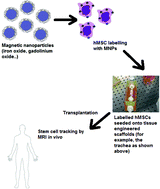Tracking the distribution of stem cells (SCs) in tissue engineered organ scaffolds is of great importance in order to understand the role, movement and distribution of SCs after they have been implanted. A recent minireview, by Hachani et al. at University College London, highlights the recent application of nanotechnology in SC labeling and magnetic resonance imaging (MRI).

For researchers wishing to gain an insight into the application of nanotechnology in MRI and stem cell research, this review provides a valuable starting point for becoming familiar with recent developments in this area.
By Lee Barrett
You can read this Minireview in Nanoscale by clicking the link below:
Tracking stem cells in tissue-engineered organs using magnetic nanoparticles
Roxanne Hachani, Mark Lowdell, Martin Birchall and Nguyễn Thi Kim Thanh
DOI: 10.1039/C3NR03861K, Minireview










